Maghreb
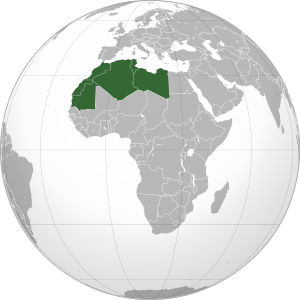
The Maghreb (/ˈmæɡrɪb/[1] or /ˈmʌɡrəb/; literally "sunset";[1] Template:Lang-ar al-Maghrib al-ʻArabī, "the Arab West"; Template:Lang-ber Tamazgha; previously known as Barbary Coast),[2][3] or the Greater Maghreb (Template:Lang-ar al-Maghrib al-Kabīr), is usually defined as much or most of the region of western North Africa or Northwest Africa, west of Egypt. The traditional definition as the region including the Atlas Mountains and the coastal plains of Morocco, Algeria, Tunisia, and Libya, was later superseded, especially following the 1989 formation of the Arab Maghreb Union, by the inclusion of Mauritania and of the disputed territory of Western Sahara (mostly controlled by Morocco). During the Al-Andalus era in Spain (711–1492), the Maghreb's inhabitants, Maghrebis, were known[by whom?] as "Moors";[4] the Muslim areas of Spain in those times were usually included in contemporary definitions of the Maghreb—hence the use of "Moorish" or "Moors" to describe the Muslim inhabitants of Spain in Western sources.
Historical terms for the region or various portions of it include Mauretania, Numidia, Libya, and Africa in classical antiquity. The term maghrib is Arabic for "west", from the verb gharaba (غرب, "to depart, withdraw"), Sensu stricto the definite form al-maghrib denotes the country of Morocco in particular. used here to refer to where the sun sets: in the west.[5][6] It identified the westernmost territories that fell to the Islamic conquests of the 7th century.[7] Today, it is a proper noun for the present region of the Maghreb, also known politically as al-maghrib al-ʻarabīy (المغرب العربي ‘the Arab Maghreb’) or al-maghrib al-kabīr (المغرب الكبير "the great Maghreb"). The Berber language's alternative term for the region, Tamazgha (‘land of the Berbers’),[8] has been popularized by Berber activists since the second half of the 20th century.
Before the establishment of modern nation states in the region during the mid-20th century, Maghreb most commonly referred to a smaller area between the Atlas Mountains in the south and the Mediterranean Sea, often also including eastern Libya, but not modern Mauritania. As recently as the late 19th century it was used to refer to the Western Mediterranean region of coastal North Africa in general, and to Algeria, Morocco and Tunisia in particular.[7]
Partially isolated from the rest of the continent by the Atlas Mountains and the Sahara desert, inhabitants of the northern parts of the Maghreb have long had commercial and cultural ties to the inhabitants of the Mediterranean countries of Southern Europe and Western Asia, going back at least to the Phoenicians in the 1st millennium BC (the Phoenician colony of Carthage having been founded, according to tradition, in what is now Tunisia circa 800 BC).
The region was somewhat unified as an independent political entity during the rule of the Berber kingdom of Numidia, which was followed by Roman Empire's rule or influence. That was followed by the brief invasion of the Germanic Vandals, the equally brief re-establishment of a weak Byzantine rule by the Byzantine Empire, the rule of the Islamic Caliphates under the Umayyads, the Abbasids, and the Fatimids. The most enduring rule was that of the local Berber empires of the Almoravids, Almohads, Hammadids, Zirids, Marinids, and Wattasids (to name some of those among the most prominent) from the 8th to 13th centuries. The Ottoman Turks ruled the region as well.
Mauritania, Morocco, Tunisia, Algeria, and Libya established the Maghreb Union in 1989 to promote cooperation and economic integration in a common market. It was envisioned initially by Muammar Gaddafi as an Arab superstate[citation needed]. The union included Western Sahara implicitly under Morocco's membership,[9] putting Morocco's long cold war with Algeria to a rest. However, this progress was short-lived, and the union is now frozen. Tensions between Algeria and Morocco over Western Sahara re-emerged strongly, reinforced by the unsolved borderline issue between the two countries. These two main conflicts have hindered progress on the union's joint goals and practically made it inactive as a whole.[10] However, the instability in the region and growing cross-border security threats revived the calls for regional cooperation – foreign ministers of the Arab Maghreb Union declared a need for coordinated security policy in May 2015 during the 33rd session of the follow-up committee meeting which brings back the hope of some form of cooperation.[11]
History
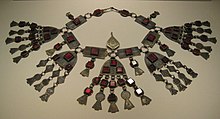
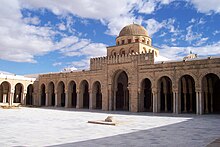
Prehistory
Around 3,500 BC a tilt in the Earth's orbit created a rapid desertification of the Sahara and formed a natural barrier that severely limited contact between the Maghreb and sub-Saharan Africa.[13] The Maghreb or western North Africa is believed to have been inhabited by Berbers since from at least 10,000 BC.[14]
Antiquity
Maghreb coast ports were predominantly occupied or constructed by the Phoenicians, who were then followed by the Carthaginians. The main Phoenician settlements centered in the Gulf of Tunis (Carthage, Utica, Tunisia) along the North African littoral between the Pillars of Hercules and the Libyan coast east of ancient Cyrenaica. They dominated the trade and intercourse of the Western Mediterranean for centuries. The Carthage defeat in the Punic Wars during 206 BC allowed Rome to establish the Province of Africa and control many of these ports and eventually control the entire Maghreb north of the Atlas Mountains. Rome was greatly helped by the defection of King Massinissa and Carthaginian's eastern Numidian Massylii client-allies. Some of the most mountainous regions such as the Moroccan Rif remained outside Rome's control and the pressures put on the Western Roman Empire by the invading forces of the Barbarian invasions (the Vandals and Spain) in the 5th-century reduced Roman control and establishment of the Vandal Kingdom with its capital at Carthage in 430 AD. A century later, the Byzantine emperor Justinian I sent a force under General Belisarius that succeeded in destroying the Vandal kingdom; Byzantine rule lasted for 150 years. The Berbers contested outside-the-area control although after the 640s-700 AD period the Arabs controlled the entire region.
Middle Ages
The Arabs reached the Maghreb in early Umayyad times. Arab expansion and the spread of Islam pushed the development of trans-Saharan trade. While restricted due to the cost and dangers, the trade was highly profitable. Commodities traded included such goods as salt, gold, ivory, and slaves. Arab control over the Maghreb was quite weak. Various Islamic variations, such as the Ibadis and the Shia, were adopted by some Berbers, often leading to scorning of Caliphal control in favour of their own interpretation of Islam.
The Arabic language became widespread only later, as a result of the invasion of the Banu Hilal, unleashed by the Fatimids in punishment for their Zirid clients' political defection and abandonment of Shiism in the 12th century. Throughout this period, the Maghreb most often was divided into three states roughly corresponding to modern Morocco, western Algeria, and eastern Algeria and Tunisia. The region was occasionally briefly unified, as under the Almohads, and briefly under the Marinids. [source?]
Early modern history
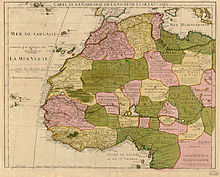
After the Middle Ages, the Ottoman Empire loosely controlled the area east of Morocco.
Modern history
After the 19th century, areas of the Maghreb were colonized by France, Spain and later Italy.
Today, more than two and a half million Maghrebi immigrants live in France, many from Algeria and Morocco. In addition, there are 3 million French of Maghrebi origin (in 1999) (with at least one grandparent from Algeria, Morocco or Tunisia).[15] Another estimation gives a number of six million.[16]
Population

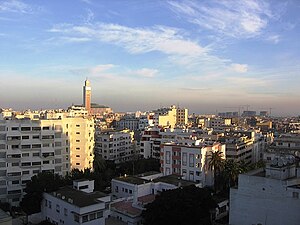
The Maghreb is home to 1 percent of the global population as of 2010. Maghrebi people include Algerians, Libyans, Mauritanians, Moroccans and Tunisians.[17] Maghrebis are largely composed of Berber and Arab descent with significantly smaller European and Sub-Saharan African elements.
Various other influences are also prominent throughout the Maghreb. In northern coastal towns, in particular, several waves of European immigrants influenced the population in the Medieval era. Most notable were the moriscos and muladies, that is, the indigenous Spaniards (Moors) who forcibly converted to Catholicism and later to be expelled, together with ethnic Arab and Berber Muslims, from the Spanish Catholic Reconquista. Other European contributions included French, Italians, and others captured by the corsairs.[18]
Historically, the Maghreb was home to significant Jewish communities called Maghrebim who predated the 7th-century introduction and conversion of the region to Islam. These were later augmented by Jews from Spain who, fleeing the Spanish Catholic Inquisition, established a presence in North Africa, chiefly in the urban trading centers. Many Jews from Spain emigrated to North America in the early 19th century or to France and Israel later in the 20th century.
Another significant group are Turks who came over with the expansion of the Ottoman Empire. A large Turkish descended population exists, particularly in Tunisia and Algeria.
Sub-Saharan Africans joined the population mix during centuries of trans-Saharan trade. Traders and slaves went to the Maghreb from the Sahel region. On the Saharan southern edge of the Maghreb are small communities of black populations, sometimes called Haratine, who are apparently descended from black populations who inhabited the Sahara during its last wet period and then migrated north.
In Algeria especially, a large European minority, the "pied noirs", immigrated and settled under French colonial rule in late 19th century. The overwhelming majority of these, however, left Algeria during and following the war for independence.[19]
Religion
The original religions of the peoples of the Maghreb seem[20] to have been based and related with fertility cults of a strong matriarchal pantheon, given the social and linguistic structures of the Amazigh cultures antedating all Egyptian and eastern, Asian, northern Mediterranean, and European influences.
Historic records of religion in the Maghreb region show its gradual inclusion in the Classical World, with coastal colonies established first by Phoenicians, some Greeks, and later extensive conquest and colonization by the Romans. By the 2nd century of the common era, the area had become a center of Phoenician-speaking Christianity, where bishops spoke and wrote in Punic, and even Emperor Septimius Severus was noted by his local accent. Roman settlers and Romanized populations converted to Christianity. The region produced figures such as Christian Church writer Tertullian (c. 155 – c. 202); and Christian Church martyrs or leading figures such as Perpetua and Felicity (martyrs, c. 200 CE); St. Cyprian of Carthage (+ 258); St. Monica; her son the philosopher St. Augustine, Bishop of Hippo I (+ 430) (1); and St. Julia of Carthage (5th century).
The domination of Christianity ended when Arab invasions brought Islam in 647. Carthage fell in 698 and the remainder of the region followed in subsequent decades. Gradual Islamization proceeded, although surviving letters showed correspondence from regional Christians to Rome up until the 9th century. Christianity was still a living faith. Christian bishoprics and dioceses continued to be active, with relations continuing with Rome. As late as Pope Benedict VII (974-983) reign, a new Archbishop of Carthage was consecrated. Evidence of Christianity in the region then faded through the 10th century.[21]
During the 7th century, the region's peoples began their nearly total conversion to Islam. There is a small but thriving Jewish community, as well as a small Christian community. Most Muslims follow the Sunni Maliki school. Small Ibadi communities remain in some areas. A strong tradition of venerating marabouts and saints' tombs is found throughout regions inhabited by Berbers. Any map of the region demonstrates the tradition by the proliferation of "Sidi"s, showing places named after the marabouts. Like some other religious traditions, this has substantially decreased over the 20th century. A network of zaouias traditionally helped proliferate basic literacy and knowledge of Islam in rural regions.
There are communities of Chrisitians mostly Roman Catholics and Protestant in Algeria, Mauritania, Morocco, Libya and Tunisia. Most of the Roman Catholics in Greater Maghreb are of French, Spanish, and Italian descent who immigranted during the colonial era, while some are foreign missionaries or immigrant worker. There is also a Christian communities of Berber or Arab descent in Greater Maghreb countries, mostly converted during the modern era or under and after French colonialism.[22][23] Due to the exodus of the pieds-noirs in the 1960s there are more North African Christians of Berber or Arab descent live in France than in Greater Maghreb. Recently, the Protestant community of Berber or Arab descent has experienced significant growth, and conversions to Christianity, especially to Evangelicalism, is common in Algeria,[24] especially in the Kabylie,[25] Morocco[26] and Tunisia.[27] A 2015 study estimates 380,000 Muslims converted to Christianity in Algeria.[28]
Maghrebi traders in Jewish history
In the 10th century, as the social and political environment in Baghdad became increasingly hostile to Jews, some Jewish traders emigrated to the Maghreb, especially Kairouan in Tunisia. Over the following two or three centuries, such Jewish traders became known as the Maghribis, a distinctive social group who traveled throughout the Mediterranean world. They passed this identification on from father to son. Their tight-knit pan-Maghreb community had the ability to use social sanctions as a credible alternative to legal recourse, which was anyway weak at the time. This unique institutional alternative permitted the Maghribis to very successfully participate in Mediterranean trade.[29]
Geography
Ecoregions
The Maghreb is divided into a Mediterranean climate region in the north, and the arid Sahara in the south. The Magreb's variations in elevation, rainfall, temperature, and soils give rise to distinct communities of plants and animals. The World Wide Fund for Nature (WWF) identifies several distinct ecoregions in the Maghreb.
Mediterranean Maghreb

The portions of the Maghreb between the Atlas Mountains and the Mediterranean Sea, along with coastal Tripolitania and Cyrenaica in Libya, are home to Mediterranean forests, woodlands, and scrub. These ecoregions share many species of plants and animals with other portions of Mediterranean Basin. The southern extent of the Mediterranean Maghreb corresponds with the 100 mm isohyet, or the southern range of the European Olive (Olea europea)[30] and Esparto Grass (Stipa tenacissima).[31]
- Mediterranean acacia-argania dry woodlands and succulent thickets (Morocco, Canary Islands (Spain), Western Sahara)
- Mediterranean dry woodlands and steppe (Algeria, Egypt, Libya, Morocco, Tunisia)
- Mediterranean woodlands and forests (Algeria, Libya, Morocco, Tunisia)
- Mediterranean conifer and mixed forests (Algeria, Morocco, Tunisia, Spain)
- Mediterranean High Atlas juniper steppe (Morocco)
Saharan Maghreb
The Sahara extends across northern Africa from the Atlantic Ocean to the Red Sea. Its central part is hyper-arid and supports little plant or animal life, but the northern portion of the desert receives occasional winter rains, while the strip along the Atlantic coast receives moisture from marine fog, which nourishes a greater variety of plants and animals. The northern edge of the Sahara corresponds to the 100 mm isohyet, which is also the northern range of the date palm (Phoenix dactylifera).[31]
- North Saharan steppe and woodlands: This ecoregion lies along the northern edge of the Sahara, next to the Mediterranean forests, woodlands, and scrub ecoregions of the Mediterranean Maghreb and Cyrenaica. Winter rains sustain shrublands and dry woodlands that form a transition between the Mediterranean climate regions to the north and the hyper-arid Sahara proper to the south. It covers 1,675,300 square km (646,800 square miles) in Algeria, Egypt, Libya, Mauritania, Morocco, Tunisia, and Western Sahara.[32]
- Atlantic coastal desert: The Atlantic coastal desert occupies a narrow strip along the Atlantic coast, where fog generated offshore by the cool Canary Current provides sufficient moisture to sustain a variety of lichens, succulents, and shrubs. It covers 39,900 square kilometres (15,400 sq mi) in Western Sahara and Mauritania.[33]
- Sahara desert: This ecoregion covers the hyper-arid central portion of the Sahara where rainfall is minimal and sporadic. Vegetation is rare, and this ecoregion consists mostly of sand dunes (erg), stone plateaus (hamada), gravel plains (reg), dry valleys (wadi), and salt flats. It covers 4,639,900 square km (1,791,500 square miles) of Algeria, Chad, Egypt, Libya, Mali, Mauritania, Niger, and Sudan.[34]
- Saharan halophytics: Seasonally flooded saline depressions in the Maghreb are home to halophytic, or salt-adapted, plant communities. The Saharan halophytics cover 54,000 square km (20,800 square miles), including Tunisian salt lakes of central Tunisia, Chott Melghir in Algeria, and other areas of Egypt, Algeria, Mauritania, and Western Sahara.[35]
Culture

The countries of the Maghreb share many cultural traditions. Among these is a culinary tradition that Habib Bourguiba defined as western Arab, where couscous is the staple food, as opposed to Eastern Arab where white rice is the staple food. In terms of food, similarities beyond the starches are found throughout the Arab world.
Genetics of the Maghreb population
The Y-chromosome genetic structure of the Maghreb population seems to be mainly modulated by geography, The Y-DNA Haplogroups E1b1b and J make up the vast majority of the genetic markers of the populations of the Maghreb. Haplogroup E1b1b is the most widespread among Maghrebi groups, especially the downstream lineage of E1b1b1b1a, which is typical of the indigenous Berbers of North-West Africa. Haplogroup J is more indicative of Middle East origins, and has its highest distribution among populations in Arabia and the Levant. Due to the distribution of E-M81(E1b1b1b1a), which has reached its highest documented levels in the world at 95-100% in some populations of the Maghreb, it has often been termed the "Berber marker" in the scientific literature. The second most common marker, Haplogroup J especially J1[36][37] which is typically Middle Eastern and originates in the Arabian peninsula can reach frequencies of up to 35% in the region.[38][39] Its highest density is founded in the Arabian Peninsula.[39] Haplogroup R1,[40] which is a Eurasian marker has also been observed in the Maghreb, though with lower frequency. The Y-DNA Haplogroups shown above are observed in both Arabs and Berber-speakers.
The Maghreb Y chromosome pool (including both Arab and Berber populations) may be summarized for most of the populations as follows where only two haplogroups E1b1b and J comprise generally more than 80% of the total chromosomes:[41][42][43][44][45][46][47][48]
| Haplogroup | n | A | B | C | DE | E1a | E1b1a | E1b1b1 | E1b1b1a | E1b1b1a1 | E1b1b1a1b | E1b1b1a2 | E1b1b1a3 | E1b1b1a4 | E1b1b1b | E1b1b1c | F | G | H | I | J1 | J2 | K | L | N | O | P,R | Q | R1a1 | R1b | R1b1a | R1b1b | R2 | T |
| Marker | M33 | M2 | M35 | M78 | V12 | V32 | V13 | V22 | V65 | M81 | M34 | M89 | M201 | M69 | M343 | V88 | M269 | M70 | ||||||||||||||||
| Sahara/Mauritania | 189 | - | 0.53 | - | - | 5.29 | 6.88 | - | - | - | - | - | - | - | 55.56 | 11.11 | - | - | - | - | 13.23 | - | - | - | - | - | - | - | - | - | 6.88 | 0.53 | - | - |
| Morocco | 760 | 0.26 | 0.66 | - | - | 2.76 | 3.29 | 4.21 | 0.79 | 0.26 | - | 0.26 | 1.84 | 3.68 | 67.37 | 0.66 | 0.26 | 0.66 | - | 0.13 | 6.32 | 1.32 | 0.53 | - | - | - | 0.26 | - | - | - | 0.92 | 3.55 | - | - |
| Algeria | 156 | - | - | - | - | 0.64 | 5.13 | 0.64 | 1.92 | 0.64 | - | 0.64 | 1.28 | 1.92 | 44.23 | 1.28 | 3.85 | - | - | - | 21.79 | 4.49 | 0.64 | - | - | - | - | 0.64 | 0.64 | - | 2.56 | 7.04 | - | - |
| Tunisia | 601 | - | 0.17 | - | - | 0.5 | 0.67 | 1.66 | - | - | - | - | 3 | 3.16 | 62.73 | 1.16 | 2.66 | 0.17 | - | 0.17 | 16.64 | 2.83 | 0.33 | - | - | - | 0.33 | - | 0.5 | - | 1.83 | 0.33 | - | 1.16 |
| Libya | - | - | - | - | - | - | - | - | - | - | - | - | - | - | - | - | - | - | - | - | - | - | - | - | - | - | - | - | - | - | - | - | - | - |
Economy
Maghreb countries by GDP (PPP)
| List by the International Monetary Fund (2013) | List by the World Bank (2013) | List by the CIA World Factbook (2013) | ||||||||||||||||||||||||||||||||||||||||||||||||||||||
|
|
|
Modern territories
Medieval regions
- Ifriqiya (currently Tunisia, East Algeria and West Libya)
- Djerid
- Sous
- M'zab
- Draa Valley
- Hodna
- Rif
- Maghreb al-Awsat (Central Maghreb - currently Northern Algeria)
- Maghreb al-Aqsa (Western Maghreb - currently Morocco)
- Maghreb al-Adna (Eastern Maghreb - currently Libya and Tunisia)
- Tamesna
- Tripolitania
See also
Notes and references
- ^ a b "Maghreb: definition of Maghreb in Oxford dictionary (British & World English)".
- ^ "Barbary Wars, 1801–1805 and 1815–1816". Retrieved 2014-06-04.
- ^ "Antique Maps of North Africa". Retrieved 2014-06-04.
- ^ "The Moors were simply Maghrebis, inhabitants of the maghreb, the western part of the Islamic world, that extends from Spain to Tunisia, and represents a homogeneous cultural entity", Titus Burckhardt, "Moorish culture in Spain". Suhail Academy. 1997, p.7
- ^ Alvarez, Lourdes María (2009). Abu Al-Ḥasan Al-Shushtarī. Paulist Press. p. 157. ISBN 978-0-8091-0582-3.
- ^ Peek, Philip M.; Yankah, Kwesi (2003-12-12). African Folklore: An Encyclopedia. Routledge. p. 442. ISBN 978-1-135-94873-3.
- ^ a b Elisee Reclus, Africa, edited by A. H. Keane, B. A., Vol. II, North-West Africa, Appleton and company, 1880, New York, p.95
- ^ "Tamazgha, North African Berbers". Retrieved 2010-02-09.; McDougall, James (2006-07-31). History and the culture of nationalism in Algeria, By James McDougall (Page: 189). ISBN 978-0-521-84373-7. Retrieved 2011-01-14.
- ^ "L'Union du Maghreb arabe". Retrieved 2010-05-17.
- ^ "Maghreb". The Columbia Encyclopedia, Sixth Edition. 2001-05. Retrieved 2007-07-11.
- ^ North Africa Post (2015) "Maghreb Countries Urged to Devise Common Security Strategy, Integration Project Remains Deadlocked" http://northafricapost.com/7594-maghreb-countries-urged-to-devise-common-security-strategy-integration-project-remains-deadlocked.html
- ^ Titus Burckhardt, Art of Islam, Language and Meaning: Commemorative Edition, World Wisdom, Inc, 2009, page 128
- ^ Sahara's Abrupt Desertification Started by Changes in Earth's Orbit, Accelerated by Atmospheric and Vegetation Feedbacks, Science Daily, http://www.sciencedaily.com/releases/1999/07/990712080500.ht
- ^ Hsain Ilahiane, Historical Dictionary of the Berbers (Imazighen)(2006), p. 112, books.google.com/books?isbn=0810864908
- ^ An Estimation of the Foreign-Origin Populations of France, Michèle Tribalat
- ^ "Estimé à six millions d'individus, l'histoire de leur enracinement, processus toujours en devenir, suscite la mise en avant de nombreuses problématiques...", « Être Maghrébins en France » in Les Cahiers de l’Orient, n° 71, troisième trimestre 2003
- ^ Brunel, Claire, Maghreb regional and global integration: a dream to be fulfilled, Peterson Institute, 2008, p.1
- ^ Davis, Robert. "British Slaves on the Barbary Coast". BBC. Retrieved 5 November 2009.
- ^ "France and Maghreb - An enhanced partnership with the Maghreb (March 20, 2007)". French ministry of Foreign and European Affairs. Retrieved 2007-07-11.
- ^ [1]
- ^ Insoll, T. (2003) "The Archaeology of Islam in Sub-Saharan Africa", Cambridge World Archaeology, http://content.schweitzer-online.de/static/content/catalog/newbooks/978/052/165/9780521651714/9780521651714_Excerpt_001.pdf
- ^ The Encyclopedia of Christianity, Volume 3
- ^ Rising numbers of Christians in Islamic countries could pose threat to social order
- ^ *Template:Fr icon Sadek Lekdja, Christianity in Kabylie, Radio France Internationale, 7 mai 2001
- ^ Lucien Oulahbib, Le monde arabe existe-t-il ?, page 12, 2005, Editions de Paris, Paris.
- ^ Morocco: General situation of Muslims who converted to Christianity, and specifically those who converted to Catholicism; their treatment by Islamists and the authorities, including state protection (2008-2011)
- ^ International Religious Freedom Report 2007: Tunisia. United States Bureau of Democracy, Human Rights and Labor (September 14, 2007). This article incorporates text from this source, which is in the public domain.
- ^ Believers in Christ from a Muslim Background: A Global Census
- ^ Avner Greif (June 1993). "Contract Enforceability and Economic Institutions in Early Trade: The Maghribi Traders' Coalition" (PDF). American Economic Association in its journal American Economic Review. Retrieved 2007-07-11.
{{cite journal}}: Cite journal requires|journal=(help); Italic or bold markup not allowed in:|publisher=(help). See also Greif's "Reputation and Coalitions in Medieval Trade: Evidence on the Maghribi Traders" in the Journal of Economic History Vol. XLIX, No. 4 (Dec. 1989) pp.857-882 - ^ Dallman, Peter R. (1998) Plant Life in the World's Mediterranean Climates. California Native Plant Society/University of California Press, Berkeley. ISBN 0-520-20809-9
- ^ a b Wickens, Gerald E. (1998) Ecophysiology of Economic Plants in Arid and Semi-Arid Lands. Springer, Berlin. ISBN 978-3-540-52171-6
- ^ "North Saharan steppe and woodlands". Terrestrial Ecoregions. World Wildlife Fund. Retrieved December 31, 2007.
- ^ "Atlantic coastal desert". Terrestrial Ecoregions. World Wildlife Fund. Retrieved December 31, 2007.
- ^ "Sahara desert". Terrestrial Ecoregions. World Wildlife Fund. Retrieved December 31, 2007.
- ^ "Saharan halophytics". Terrestrial Ecoregions. World Wildlife Fund. Retrieved December 31, 2007.
- ^ combined (Semino et al. 2004 30%) & (Arredi et al. 2004 32%)
- ^ [2]
- ^ Alshamali F, Pereira L, Budowle B, Poloni ES, Currat M (2009). "Local population structure in Arabian Peninsula revealed by Y-STR diversity". Hum. Hered. 68 (1): 45–54. doi:10.1159/000210448. PMID 19339785.
{{cite journal}}: CS1 maint: multiple names: authors list (link) - ^ a b *Alshamali et al. 2009 81% (84/104) *Malouf et al. 2008: 70% (28/40) *Cadenas et al. 2008:45/62 = 72.6% J1-M267
- ^ Analysis of Y-chromosomal SNP haplogroups and STR haplotypes in an Algerian population sample
- ^ Bosch E, Calafell F, Comas D, et al. (April 2001). "High-Resolution Analysis of Human Y-Chromosome Variation Shows a Sharp Discontinuity and Limited Gene Flow between Northwestern Africa and the Iberian Peninsula". The American Journal of Human Genetics. 68 (4): 1019–29. doi:10.1086/319521. ISSN 0002-9297. PMC 1275654. PMID 11254456.
- ^ Nebel A, Landau-Tasseron E, Filon D, et al. (June 2002). "Genetic Evidence for the Expansion of Arabian Tribes into the Southern Levant and North Africa". The American Journal of Human Genetics. 70 (6): 1594–6. doi:10.1086/340669. ISSN 0002-9297. PMC 379148. PMID 11992266.
- ^ Semino O, Magri C, Benuzzi G, et al. (May 2004). "Origin, Diffusion, and Differentiation of Y-Chromosome Haplogroups E and J: Inferences on the Neolithization of Europe and Later Migratory Events in the Mediterranean Area". The American Journal of Human Genetics. 74 (5): 1023–34. doi:10.1086/386295. ISSN 0002-9297. PMC 1181965. PMID 15069642.
- ^ Arredi B, Poloni ES, Paracchini S, et al. (August 2004). "A Predominantly Neolithic Origin for Y-Chromosomal DNA Variation in North Africa". The American Journal of Human Genetics. 75 (2): 338–345. doi:10.1086/423147. ISSN 0002-9297. PMC 1216069. PMID 15202071.
- ^ Cruciani F, La Fratta R, Santolamazza P, et al. (May 2004). "Phylogeographic Analysis of Haplogroup E3b (E-M215) Y Chromosomes Reveals Multiple Migratory Events Within and Out Of Africa". The American Journal of Human Genetics. 74 (5): 1014–22. doi:10.1086/386294. ISSN 0002-9297. PMC 1181964. PMID 15042509.
- ^ Robino C, Crobu F, Di Gaetano C, et al. (May 2008). "Analysis of Y-chromosomal SNP haplogroups and STR haplotypes in an Algerian population sample". International Journal of Legal Medicine. 122 (3): 251–5. doi:10.1007/s00414-007-0203-5. ISSN 0937-9827. PMID 17909833.
- ^ Onofri V, Alessandrini F, Turchi C, et al. (August 2008). "Y-chromosome markers distribution in Northern Africa: High-resolution SNP and STR analysis in Tunisia and Morocco populations". Forensic Science International: Genetics Supplement Series. 1 (1): 235–6. doi:10.1016/j.fsigss.2007.10.173.
- ^ Bekada A, Fregel R, Cabrera VM, Larruga JM, Pestano J, et al. (2013) Introducing the Algerian Mitochondrial DNA and Y-Chromosome Profiles into the North African Landscape. PLoS ONE 8(2): e56775. doi:10.1371/journal.pone.0056775
External links
 Media related to Maghreb at Wikimedia Commons
Media related to Maghreb at Wikimedia Commons- Politics, economics, and human affairs analysis in the Maghhreb
- Maghreb Radio Stations
- News and Views of the Maghreb
- Peacekeeping mission in Maghreb: The MINURSO
